It was now March 7th and I had 123 species – less than 20% of the month gone and more than 61% of the needed species found. BUT after that initial 1000 batting average on the first part of Day 1 for the important targets, I was now hovering around 50%. If the trend continued or yikes went further down, 200 could be in trouble. I had signed up for a Pelagic Trip out of Westport for March 26th and I was now looking on that trip as important money in the bank – promising at least 6 and probably more species. Day 7 would be going to an important different habitat as I continued to follow the plan I had initially designed – take the ferry from Edmonds to Kingston and continuing north on the Olympic Peninsula birding in Kitsap, Jefferson and Clallam Counties.
The key targets for my trip were a LESSER BLACK BACKED GULL in Sequim, an EARED GREBE at Port Gamble and an ANCIENT MURRELET somewhere in Port Townsend. My first new species was a CALIFORNIA GULL at the Kingston ferry terminal and then despite a less than favorable tide, I had some BONAPARTE’S GULLS at Point No Point where there are often hundreds of these lovely little gulls. Somewhat early VIOLET GREEN SWALLOWS flew over and CALIFORNIA SCRUB JAYS which are now regular there also obliged with an appearance. Early in my birding life I had seen a very rare ARCTIC LOON at Port Gamble but in more recent years, I had driven through the area (v-e-r-y s-l-o-w-l-y with its 25 mph limit) on my way to other birding spots. This time I made the stop and was fortunately able to pick out the single EARED GREBE among the 15 or so HORNED GREBES. It was 9:30 a.m. and I had added 5 species – so far so good.
On to Sequim where a LESSER BLACK BACKED GULL had been seen regularly for more than two months either at Maple View Farm (where I had seen it earlier in January) or at the lagoon near the Pacific Northwest National Laboratory. I did not see it at the farm and then went to the north area of the lagoon and hiked in from Marlyn Nelson Park where I got only a distant scope view after much searching. I then went to another vantage point at the south end only to see the gull fly back north after a brief good look. Altogether that took over an hour – more than expected but definitely ok for a really good species even without a photo.
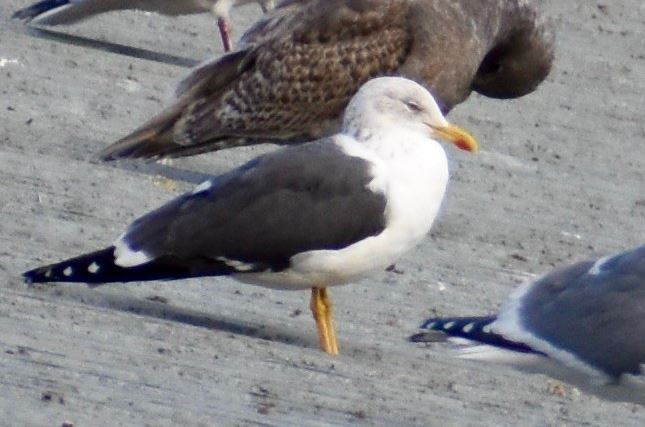
On the way to 3 Crabs in Sequim I found my first MOURNING DOVES of the month and some GREATER WHITE FRONTED GEESE, another first. At 3 Crabs itself I found only some SANDERLINGS where other shorebirds could have been possibilities and where LONG TAILED DUCKS had been seen recently. I then went to Railroad Bridge Park expecting to find an AMERICAN DIPPER which is regular there – but no such luck adding only a CHESTNUT BACKED CHICKADEE. I planned to end the trip back tracking to two spots at Port Townsend hoping for some alcids. Along the way I had my first and somewhat early TURKEY VULTURE. Hundreds of alcids had been seen in Port Townsend in earlier weeks. This day there were almost none – a single, and appreciated MARBLED MURRELET, hundreds of RHINOCEROS AUKLETS – and maybe 10 PIGEON GUILLEMOTS. The MARBLED MURRELET was new but I had high hopes for its fancier and rarer cousin, an ANCIENT MURRELET. I considered the long way home taking the ferry from Port Townsend to Whidbey Island, but the schedule was wrong and day was already long. Leaving Port Townsend I had a flyby COOPER’S HAWK.
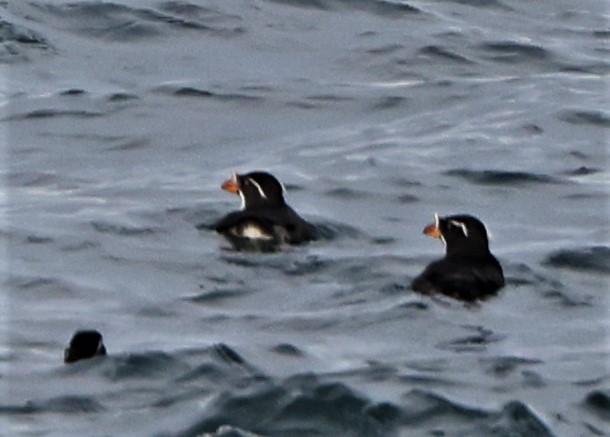
I should have been pretty happy with the day adding 13 species and finding two or three main targets, but missing the ANCIENT MURRELET and AMERICAN DIPPER left a sour taste which was made worse when I later remembered that a BLUE JAY had been reported regularly in Port Townsend – just blocks from where I had been and then saw that Bob Boekelheide had relocated the very rare DICKCISSEL within a mile of where I had been in Sequim. Had I checked current Ebird reports while in the area, I might have found both species. The trouble with a “Big” anything is that the misses resonate harder and longer than the successes. End of Day 7 – 136 species found.
Day 8 would be another different habitat, my first trip to the Coast (Pacific Ocean) for 2022. On most trips to the Coast, I either focus on the area south of Aberdeen down to Westport and Tokeland or the area west of Aberdeen including Hoquiam and Ocean Shores. There is some overlap between the two habitats but also some significant differences. The Hoquiam STP just west of Aberdeen can be good for shorebirds and ducks and some passerines. The jetty at Ocean Shores is easier to bird and is better for Rockpipers than the jetty at Westport and the open beach there is often better for SEMIPALMATED PLOVERS. Later in the year, Ocean Shores including Bill’s Spit and the Game Range will be better for many shorebirds. On the other hand the open beach south of Westport is generally better for SNOWY PLOVERS and Tokeland further south is the only reliable spot in Washington for WILLETS and is often good for MARBLED GODWITS. Covering both spots is possible but means less time available at each and possible complications with the tides. I felt I had to try both and got off to an early start accordingly.
It would not be the last time that heavy winds and less than ideal tides would complicate matters. Overall the day proved disappointing despite some major successes and a big surprise. The big surprise was at the Hoquiam Sewage Treatment Plant (STP) where although I found a respectable 25 species, there were no shorebirds. There was a very responsive FOX SPARROW and a very surprising RED SHOULDERED HAWK. I had a RED SHOULDERED HAWK there once before – possibly my best view ever, but this was completely unexpected, a species that was on my target list for Clark County later.

When I got to Ocean Shores, I started to drive on the open beach just south of the Casino but the tide was low and the wind was fierce. There were a few gulls and mothing else so I retreated and headed directly to the Point Brown Jetty. The wind was no better there and waves were crashing over the rocks. This can be a great place for BLACK TURNSTONES, ROCK SANDPIPERS and SURFBIRDS. I have had all three of them within a couple feet of each other in the past. For quite a while all I could see were some gulls and crows. Then some shorebirds flew from the backside at the far end of the jetty to the front where they were visible to me – two obvious BLACK TURNSTONES with their distinctive black and white pattern and another shorebird that was about the same size or perhaps a bit smaller that was either a ROCK SANDPIPER or a SURFBIRD. It was only for a brief second or two as it landed on the rocks, but through my scope I could make it out as a ROCK SANDPIPER with a different bill shape, speckling and brighter legs. It was probably the first or second most important species to find on the trip, so I was very pleased. The BLACK TURNSTONE was new as well, but could readily be found in other places – usually.
I wanted to get to Tokeland and Grayland Beach on the other side of Grays Harbor so I did not return to the open beach and headed back east and then south. When I arrived at Tokeland, I was again a bit dismayed by the wind and tide. Often WILLETS are easily seen right at the marina before getting to the fishing pier and MARBBLED GODWITS are across the little cove on a spit of land. It took a little longer to find them this time, but I located a group of 13 WILLETS in the grass at the northwest end of the cove. Unfortunately no MARBLED GODWITS were in view. There are usually numerous WESTERN GREBES further out in the bay sometimes joined by a CLARK’S GREBE. I found only two WESTERN GREBES this time – both quite distant.
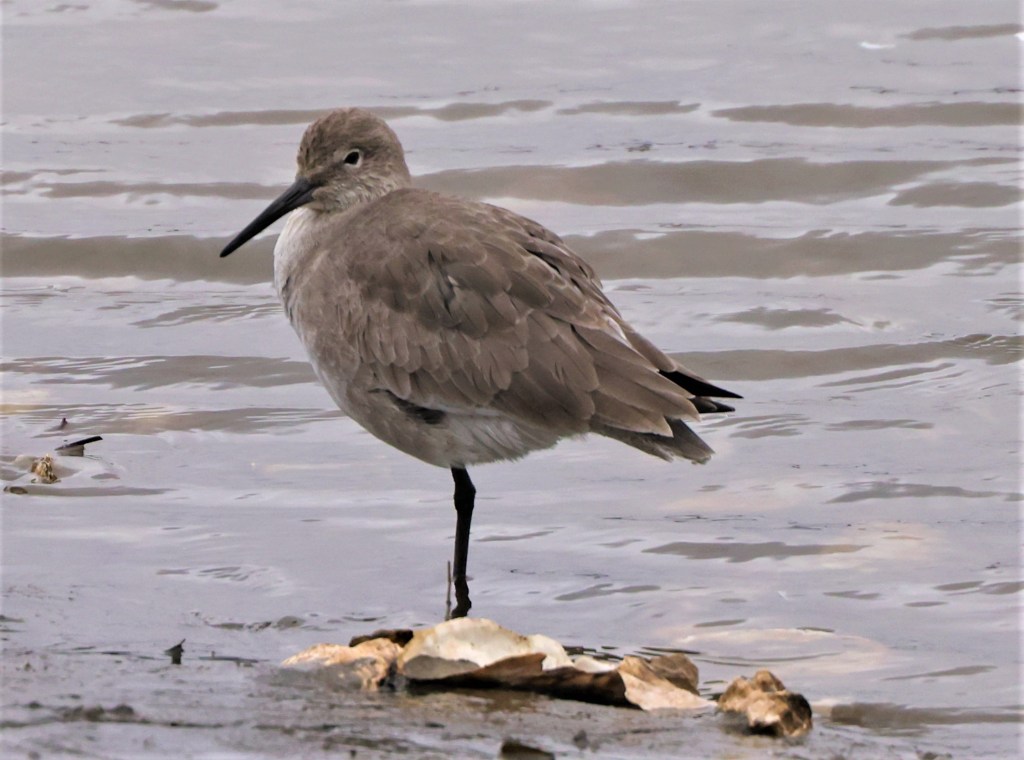
On the way out of Tokeland to head back north to Grayland, I passed through a small flock of GREATER WHITE FRONTED GEESE. There often seem to be these geese at Tokeland. They are not rare but can easily be missed. What I did not do was check Graveland Spit halfway up the Tokeland Peninsula. When the MARBLED GODWITS are not in the Marina, they can often be found there. User error – I simply forgot to check. Instead I went directly to Midway Beach near Grayland looking for shorebirds – especially SNOWY PLOVERS.
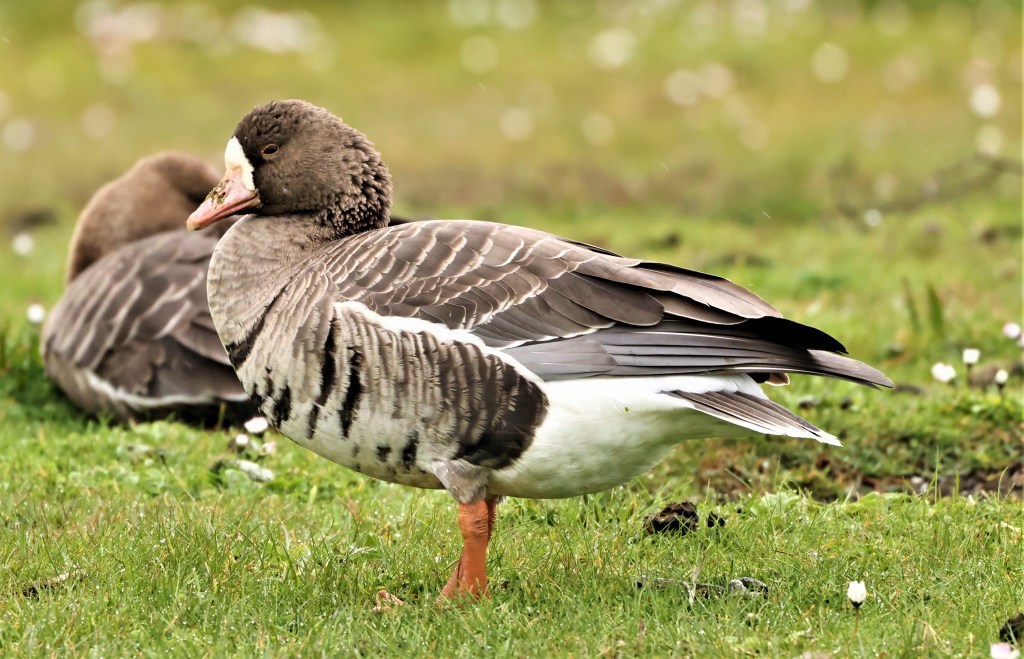
There were surprisingly few birds on the beach – lots of SANDERLINGS as expected but the only other species were a few gulls, a PEREGRINE FALCON, and fortunately 5 SNOWY PLOVERS. In my planning I had expected MARBLED GODWITS and SEMIPALMATED PLOVERS for sure. I was grateful for the SNOWIES but was already wondering how to make up for the others.
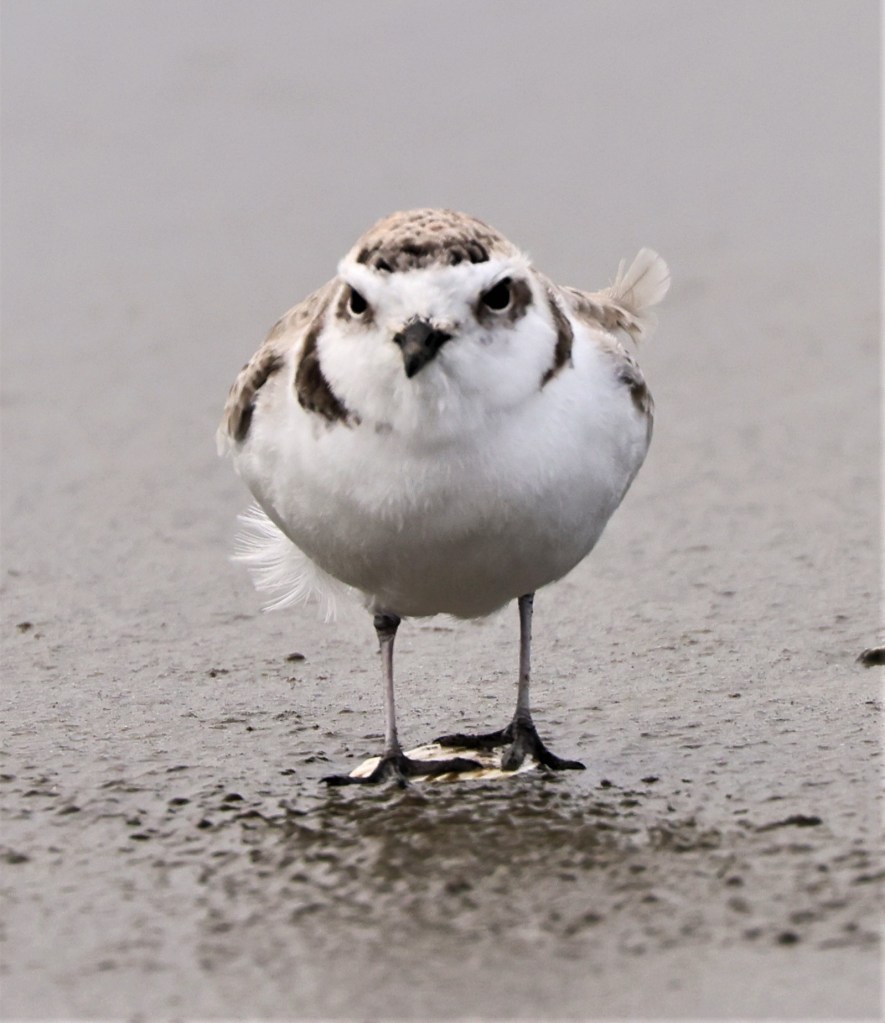
It was a hard day to assess – definitely some missed shorebirds, but the RED SHOULDERED HAWK was a major bonus and finding the SNOWY PLOVERS, BLACK TURNSTONES, ROCK SANDPIPER, and WILLETS were expected but still good finds. The seven new species for March brought me to 143, still behind schedule but still energized. The next day would again challenge that feeling.
Many TOWNSEND’S WARBLERS overwinter in the area. One was a regular at the feeder of good birding friend Steve Pink in Edmonds. Day 9 of Big March started with a visit to the feeder that quickly produced the targeted species as well as good conversation as Steve and wife Connie joined me for a bit. I then continued north trying again for species missed earlier in Skagit County.
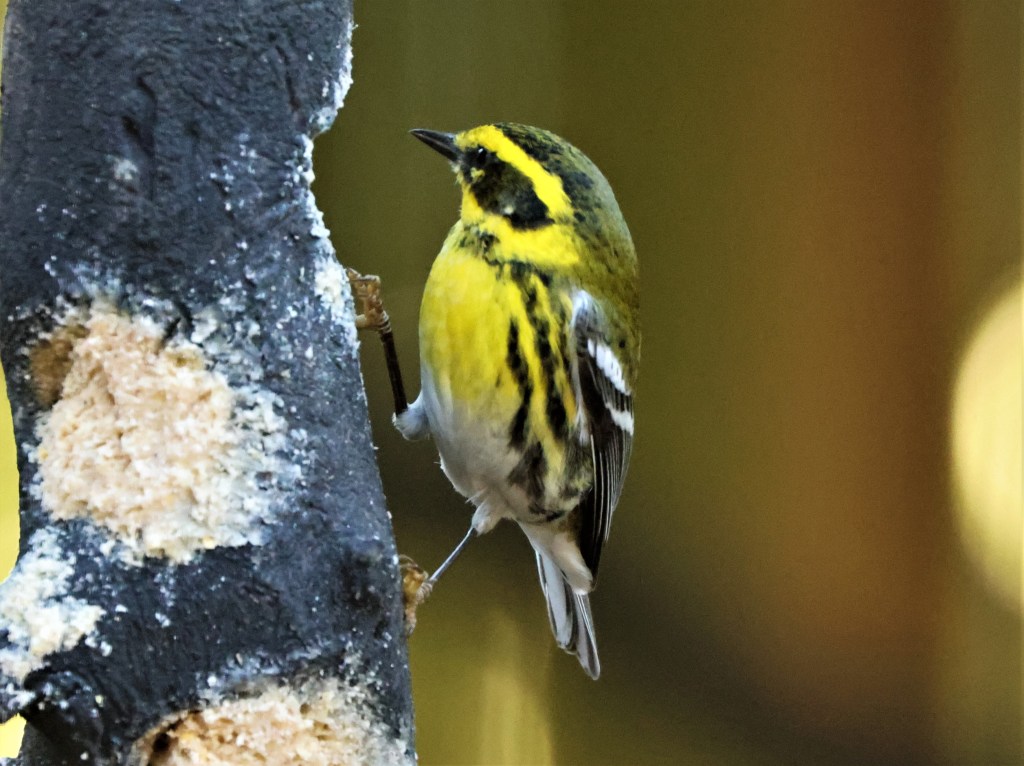
I again started at Wylie Slough and this time had a little better luck adding TREE SWALLOW, GREATER YELLOWLEGS and VIRGINIA RAIL to the month list. I looked again unsuccessfully for GYRFALCON and PRAIRIE FALCON at Samish Flats and also tried again for LONG TAILED DUCK at the Samish Island Overlook. They were quite distant but they were there and I got a terrible photo as proof. Somehow making up for the earlier miss buoyed my spirits and I went home earl feeling good with now 148 species for the month.

Day 10 was another relatively short day as I had obligations that meant I could not be out all day. It did not add a lot of new species but it added a lot of fun. It started with a successful chase of a RED BREASTED SAPSUCKER at a park in Lynnwood and then a failed search for BAND TAILED PIGEONS at an often reliable place in North Seattle. There was a big consolation prize however. The go to place was the feeder at the home of Dennis Paulson, a legendary naturalist, ornithologist and birder who among many others things has taught the Seattle Audubon Master Birder Class for over 20 (or maybe 30) years. A good friend and resource for all ID help, Dennis saw me outside and invited me in where I visited for more than a half hour with him and partner Netta Smith as we watched their feeder. No BAND TAILS but both forms of WHITE THROATED SPARROWS made an appearance together with great looks at another TOWNSEND”S WARBLER, finches, sparrows and a VARIED THRUSH among others. Birds are great; people are better; and great people who are great birders are the best. This was some of the best.

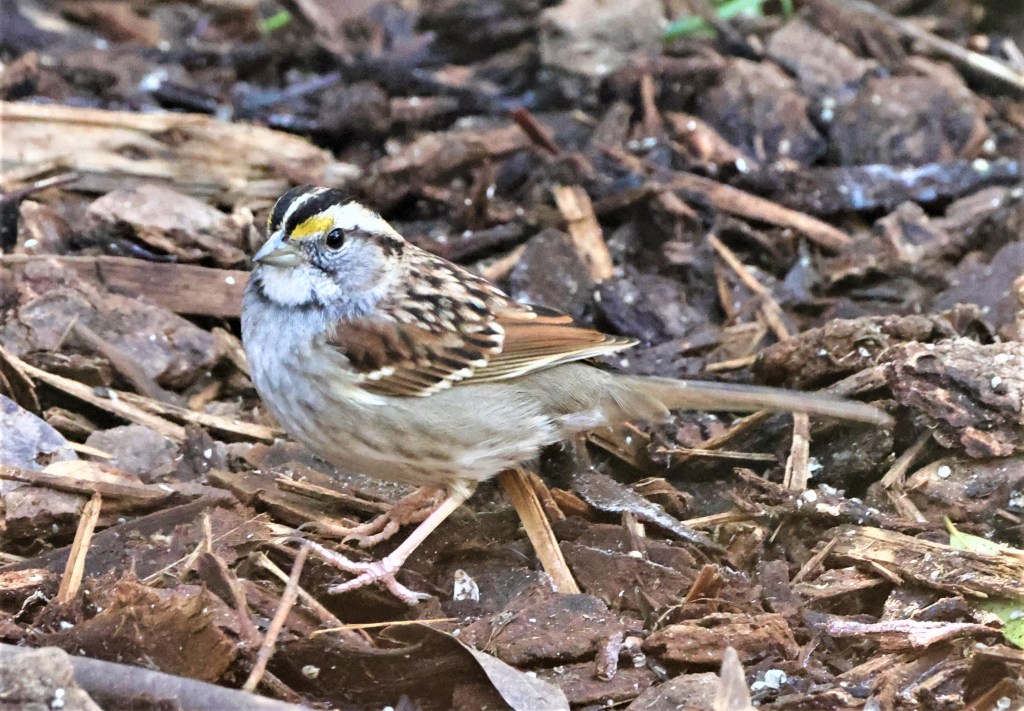
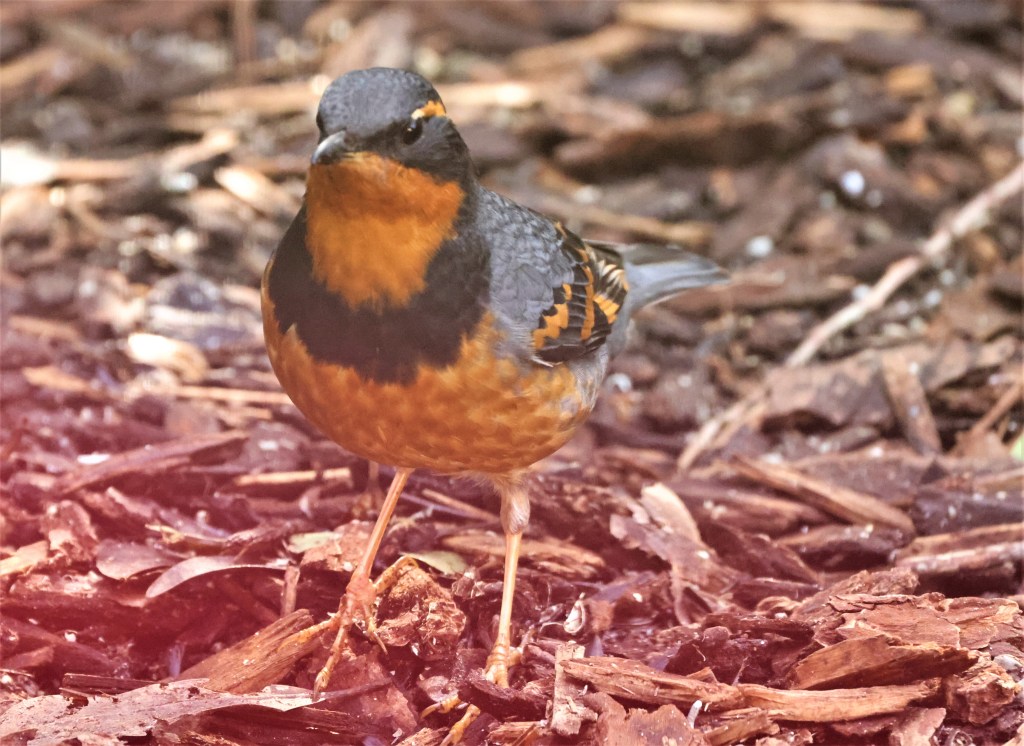
At nearby Magnuson Park I found a couple of CEDAR WAXWINGS and got better looks and some photos of CALIFORNIA GULLS which I had seen previously. I then returned to Edmonds to a favorite local park – Pine Ridge. No BARRED OWL but I added HUTTON’S VIREO and SHARP SHINNED HAWK. 5 new species for the day and now more than 75% to the target 200 at 153 species for the month. The next day was mostly a day off with only a brief visit to an Edmonds neighborhood where I did find BAND TAILED PIGEONS and a visit to the Edmonds Fishing Pier where I found BLACK TURNSTONES but not the targeted SURFBIRD.

In my original project planning, I projected a trip to Clark County (one of the southern most counties in the state) as a go to place for RED SHOULDERED HAWK, GREAT EGRET, and SANDHILL CRANE all of which were certainly possible elsewhere as well as for WILSON’S SNIPE and CALIFORNIA SCRUBJAY – even more possible elsewhere but Clark County would be a safety backup. Additionally there had been reports of early LESSER YELLOWLEGS, SAVANNAH SPARROW, and COMMON YELLOWTHROAT – all on the hit list for the month but not yet reliable anywhere else. Depending on my energy level and timing, there was also the possibility of making it a really long day and continuing on to Klickitat County for ACORN and LEWIS’S WOODPECKER.
On March 12, I got a real early start and 3 hours later was at Ridgefield Refuge at 7:30 a.m. (As I said a real early start!) I very slowly made the drive around the auto loop at the river S Unit with several stops along the way. Immediately an AMERICAN KESTREL landed on the ground not 15 feet from my car. Would this be a harbinger of good things to come?

All told it took over an hour and a half to travel under 5 miles – I could have walked the circuit just as fast but that is not permitted and would not have been nearly as successful (or as comfortable). The River S Unit is both wonderful and frustrating. The waterfowl especially are fantastic although often distant and challenging to see especially when constrained to your car. There are lots of other birds species as well – equally or more challenging with the “don’t get out of your car” constraints for most of the circuit. Nonetheless I was able to find 40 species – about evenly split between those that were water oriented and those that were not. It’s a good thing that I had seen WILSON’S SNIPE and RED SHOULDERED HAWK elsewhere, because I did not find them at Ridgefield. I usually have had GREAT EGRET there as well – but not this time. Fortunately, however, I was able to locate the LESSER YELLOWLEGS and COMMON YELLOWTHROAT and had a small group of SANDHILL CRANES.
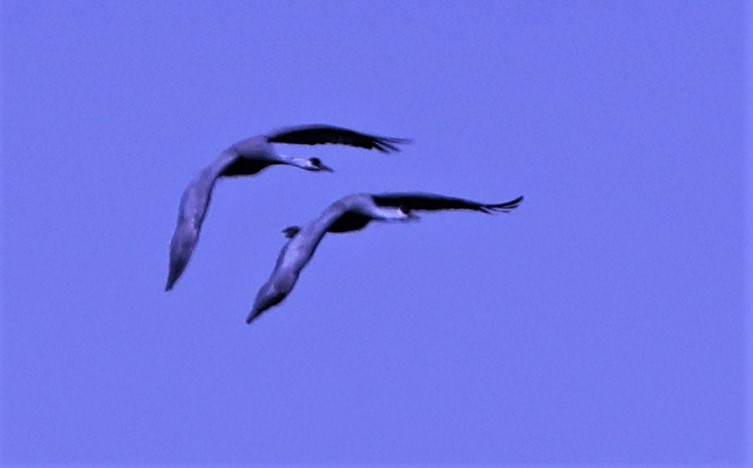
For several years a very rare for Washington SNOWY EGRET had been found regularly at the end of River Road – south and west of Ridgefield. It departed last year but the area was still good for GREAT EGRET and I did find one there as well as a SAVANNAH SPARROW and a RED SHOULDERED HAWK. Decision time. It was noon and Lyle in Klickitat County was about 85 miles away – not so bad but that would mean a 4+ hour drive to return home. It was the only reliable place for ACORN WOODPECKER and would also give me a LEWIS’S WOODPECKER making a trip later to Fort Simcoe or Oak Creek unnecessary. The weather was good – off I went.
The area around Balch Lake has been the go to place for ACORN WOODPECKER’S in Washington for years. Later it is also the best place for ASH THROATED FLYCATCHER. LEWIS’S WOODPERCKER are plentiful and easy to find – I had one within minutes of arriving in the area. ACORN WOODPECKER can be tougher. My best luck in the past couple of years had been at McClane Tuthill Road and it was productive again. I had three fly overhead and perch in a distant Live Oak – good enough to count and for a mediocre photo. Then I had more later.


Had I done a better job of planning I would have delayed the trip to Clark County for at least another 10 days and probably added an overnight somewhere to allow more time in and coming back from Klickitat County as a number of species arrived later in March migrating north. I also could have coordinated the trip with time in other good habitats returning from Klickitat County. Maybe next time – oh, wait there will NOT be a next time for a Big March!!! The trip had been long and productive qualitatively and quantitatively – adding 7 species to get to 161 for the month. I was torn between 161 sounding like a lot so far and 39 sounding like a lot still needed.
After the long day on the 12th, Day 13, a Sunday, was spent pretty close to home starting with a visit to Alki in West Seattle chasing a CLARK’S GREBE that had been seen in a large flock of WESTERN GREBES. Maybe I was at the wrong place but my view of the flock of grebes was very distant and often obscured by heavy waves in the wind. I counted at least 40 grebes and with 60X magnification could find the one that was “different” with a yellow/orange bill and barely visible white surrounding the eye. I then headed north to once more look for the GLAUCOUS GULL that every birder in the area except me had seen either at Log Boom Park or on light posts in Kenmore across from McDonald’s or Rite Aid or … or… I had looked for the gull at least ten times in February and March. There had been gulls on some light posts but none were GLAUCOUS. I had counted on seeing this bird as part of the Big March project. It almost didn’t happen but this turned out to be the day. Most recent reports had been from Log Boom Park itself so that is where I started. Not there but when I walked out along the docks to the north I could see a bunch of gulls on the roof of a shed at the boat repair shop a bit north. One of the gulls seemed right but it was mostly perched on the downside of the roof – affording only a partial view. When it moved slightly towards the crown of the roof, I could make it out better and was sure I had the target but really a frustrating view.
I drove to the repair shop and could see even more gulls on the formerly hidden side of the roof. The GLAUCOUS GULL was there in the open – until – the bastard flew off and maybe landed on the other side of the roof – now completely invisible to me. Literally a few moments later, a birding couple joined me looking for the gull. I told them they had just missed it and it might be back at Log Boom Park or just on the other side of the roof. Having finally seen it and being very tired of the chase, I left. They remained and I learned from their Ebird report later that it had returned to the northern side of the roof maybe 10 minutes later. This would not be my only frustrating gull story for the day.
There is often a large gathering of gulls at the big parking area at Everett Marine Park – at times many dozens. They hang out there because many people bring bread and chips and what not to feed them. As a new car drives up, the flock flies over to greet the newcomer to see what treats have arrived. It being Sunday, there were several cars there when I got there and a large flock of gulls was split arranging themselves around each car looking for handouts. If there are enough gulls present, there is almost always at least one HERRING GULL and often ICELAND GULLS as well as our OLYMPIC GULL hybrids (GLAUCOUS WINGED X WESTERN) plus RINGED and SHORT BILLED GULLS and sometimes CALIFORNIA GULLS. I began the search for a gull with pink legs, dark wing tips and a yellow/pale eye. The gulls were squawking and moving around, but I finally found one in one of the groups and got a quick photo.
Then the “fun” began. A couple drove up and unleashed two young boys – I am guessing around 8 years old. They delighted in running at and through the gulls making them fly off only to land at another spot and then the boys would repeat the chase screaming and shrieking with the full encouragement and applause from the parents. Then the dog got out of the car and joining them adding barks to shrieks and the chaos. I was fuming and was about to confront the parents but figured it was just not worth it and would probably not do any good. My final thought was “probably voted for Trump” and then I left.

Three odd birding experiences but three new species for the month and I FINALLY GOT THAT GLAUCOUS GULL!! and was at 164 species. I ended the second week of March with a return trip to Port Townsend going for the BLUE JAY and hoping for an ANCIENT MURRELET (again). I got to the neighborhood in Port Townsend where the BLUE JAY had been seen regularly around 9:45 a.m. and just kept walking the area around Rose Street. A couple of residents asked me if I was looking “for the Jay”. They had seen it – but not that morning. There were lots of thickets, shrubs and trees and a fair number of birds but it was very windy and whenever a bird would come out in the open, it would be blown over to another area where it would return to cover in some growth. I heard a finch singing and checked my recordings and confirmed it was a new for the month PURPLE FINCH. It even responded to playback but would never come out from hiding. After more than 30 minutes I heard a JAY calling – but it was only a STELLER’S JAY. It flew overhead like a rocket ship – caught in the wind. I continued my circumnavigation of a 4 block area. At the corner of Willow and H streets I heard another JAY – this one was my hoped for BLUE JAY with its familiar down slurred squawking call. I could just barely make it out buried near the top of a thicket – a familiar bird from the East and seen somewhere every year in Washington. It took an hour but “check” – another species.
Then it was over to Point Wilson at Fort Worden. The wind was fierce and the Sound was tossing whitecaps accordingly. I was not optimistic as I walked out towards the Lighthouse which is closed. The wind was so strong it was impossible to hold a camera steady and the only way I could use the scope was to put heavy pressure on it from the top with my left hand as I held the tripod with my right. Even then it was challenging until I partially hid myself behind one of the buildings which at least blocked the full blast of the wind. Definitely not ideal sea-watching conditions. But there were birds. Lots of birds. There was an endless stream of RHINOCEROS AUKLETS. I estimated at least 500 but there could have twice that many. I also counted more than 30 RED BREASTED MERGANSERS zooming by. I believe that MERGANSERS are the fastest flying ducks. With this tailwind they were even faster. Again there may have been many more as I was only able to see and count them as they flew past and not any actually in the tossing water.
I could count some PIGEON GUILLEMOTS on the water, their contrasting black and white aiding that effort. Even more flew past like black bullets with white wing patches. Then 2 more bullets flew by – smaller than the GUILLEMOTS, also black and white but the white was underneath and the wings were solid black. They were sufficiently close that I could make out the white patches on the side of their heads just as they disappeared in the wind. They were ANCIENT MURRELETS. A second group – a single pair -flew by further out. There were almost certainly more. I braved it out for just under an hour fascinated by the show of RHINOS and hoping for more AUKLETS. Fighting the wind was actually exhausting and as I would be heading off the nest day for a three day trip to Walla Walla and other areas in Eastern Washington, and with both targets seen for the day plus a bonus PURPLE FINCH, I called it quits and headed home – just missing one ferry and being the second car on the next one.
Two weeks of Big March were in the books. I had birded at least a little bit every day and had seen 167 species. Had I been luckier or better I would have could have should have been over 175 species. Somehow that 8 species differential loomed large but I could make it go away with a good trip East. You can see what happened in Part III of Big March.

Just a joy to read these two posts . Thanks for taking the time to write and share with us about your adventures. I love how you always have a new birding project it helps to keep this hobby interesting!
Happy Easter my friend
Mel
LikeLike